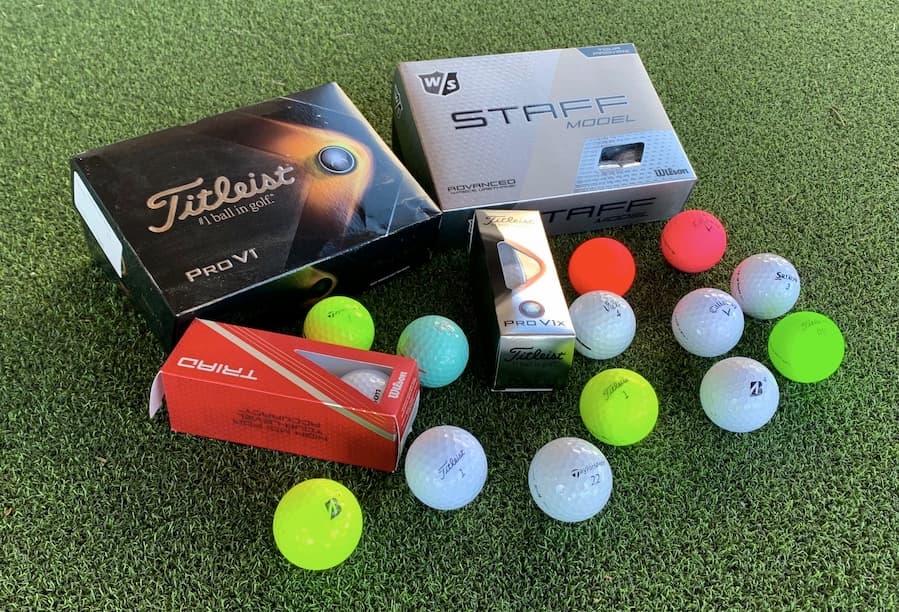Golf balls can play an important factor in your game. Choosing which golf ball you should use can depend on many factors: your desired ball flight or roll, your golf swing, your best friend’s recommendation or even how it looks. Let’s break down the different types and ratings of balls and which balls are best for you.
You want to ensure you’re using the right type of ball depending on your skill level, your swing speed and the type of course you’re playing.
Fortunately, there are some straight-forward suggestions on the type of ball you choose. I will explain the factors in choosing the right golf ball and also provide you statistics on current golf balls on the market so you have an idea of what balls are suited for your game.
After that, it’s all about personal preference and what gives you the most comfort and best chance to succeed at your own game.
How Ball Compression Affects Your Golf Shot
In the old days, you could always choose what compression of ball you wanted to play. These days, balls don’t have the compression level labeled but let’s discuss what compression means and how it can affect your shots depending on your swing speed.
A golf ball is compressed (flattened) upon impact from the clubhead. From this point, the compression rating of the ball will have an impact on what the ball does, depending on the swing speed of the club.
Golf balls have compression ratings of 70, 80 and 90. The lower the number the softer the golf ball, allowing for further distance. The higher the number the harder the ball, allowing for greater control.
Golf Ball Compression is Influenced by Your Swing Speed
Balls with lower compression ratings of 70 and 80 are typically designed for more novice golfers, as golf balls will travel further at slower swing speeds. Balls with lower compression ratings will spring more off the club. Beginner players or golfers with slower swing speeds may prefer balls with lower compression in order to get more distance and shorten the length of longer courses.
Balls with a higher compression rating (90) are usually used by more advanced players with faster swing speeds, which allow them to control the ball better at longer distances. Balls with a higher compression rating are harder and don’t spring as much, allowing for better control.
Professionals and more advanced players already get plenty of distance from their swing speed and form, so they are oftentimes looking for more accuracy than distance.
What are Golf Ball Dimples For?
Golf balls have between 300 – 500 dimples on them. They may seem randomly placed but they are designed the way they are for a specific reason.
Dimples affect the aerodynamics of a golf ball. If you tried to hit a perfectly round and smooth ball, you would only be able to hit it at about half the distance as a regular dimpled golf ball. This is because the dimples provide lift and reduce drag on the ball in flight.
How Dimples Affect Drag
Dimples allow for air to flow more smoothly around the ball, reducing the wind resistance and drag on the ball. A reduction in drag allows the ball to travel a further distance.
How Dimples Affect Lift
Dimples increase lift by allowing the air to move faster at the top of the ball. This results in lower pressure on top of the ball and higher pressure below the ball, resulting in increased lift.
Variations in dimples are depth, pattern and size which all affect the lift and drag forces of a golf ball. Dimples are usually circular in shape but there are some balls out there now that have hexagonal shapes such as the Callaway Hex Diablo which are designed to increase lift.
The USGA has a great video showing dimples’ effect on a ball’s flight.
Average Golf Swing Speeds
You need to match the ball to your swing and not match the swing to your golf ball. For example, if you have average clubhead speed and use a high compressed ball compared to a medium compressed ball, you will most likely get more distance with the medium one.
Here is the average breakdown of the swing speed of golfers.
- Male amateurs – 93mph
- PGA Tour – 114mph
- Female amateurs – 78 mph
- LPGA Tour – 94mph
- Pro Long Drivers (and Bryson DeChambeau) – 135mph
In the old days golf ball manufacturers would label each ball with the compression rating (i.e. Professional 90 or Professional 100). Now, compression ratings are no longer labeled so you have to do your own research. Fortunately for you, I did some of that work for you!
Golf Ball Compression and Trajectory Ratings
Below is a list of golf balls currently on the market along with their compression, swing speed and trajectory ratings.
**Bridgestone Tour B XS & B RXS – 85 compression (90-105mph)
Callaway Chrome Soft X – 90 compression (90-115mph) high trajectory
Srixon Z-Star – 90 compression (90-115mph) high trajectory
Taylormade TP5X – 90 compression (90-115mph) high trajectory
Titleist Pro V1X – 97 compression (90-115mph) high trajectory
Titleist Pro V1 – 97 compression (85-115mph) mid trajectory
Taylormade TP5 – 80 compression (85-110mph) mid trajectory
Vice Pro Plus – higher compression (85-110mph) low trajectory
**Wilson Staff Model – 100 compression (85-115mph) high trajectory
Titleist AVX – 80 compression (80-100mph) low trajectory
Callaway Chrome Soft – 75 compression (80-100mph) mid trajectory
Vice Pro – medium compression (80-95mph) mid trajectory
**Taylormade Tour Response – 70 compression (80-95mph) high trajectory
Srixon Q-Star – 75 compression (80-95mph) high trajectory
**Titleist Tour Soft – 65 compression (75-95mph) mid trajectory
Bridgestone Tour B RX- 65 compression (70-85mph)
Callaway Supersoft – 40 compression (70-85mph) high trajectory
**Wilson Duo Soft – 35 compression (65-85mph) mid trajectory
Srixon Soft Feel – 60 compression (65-80mph)
**Bridgestone e6 – 45 compression (65-80mph)
Wilson Duo Optix – 40 compression (65-80mph) mid trajectory
**Highly recommend for value
Short Game Feel (Best Golf Balls for Short Game)
Being confident around and on the greens is how you score well in golf so you better feel comfortable with how your ball reacts off your clubfaces. You may not feel much difference off the tee but you should feel comfortable how the ball reacts when hitting the greens, chipping around the greens or rolling it with your putter.
Look out for Golf Ball Deals
I recommended some great value balls that can make your score better and keep your wallet thicker. If you are a part of a club or receive emails, some companies have a promotion in the spring that you can buy 3 dozen and get one for free. Some even include free personalization on the ball either by picking a number or a short message and lettering. So take advantage of this and load up for the season. This can also be good for presents for friends and family later in the year.
Choose the Balls That Give You the Most Confidence
Overall, some golfers just want to use the golf balls the best players in the world do even though these balls may not be a perfect match for their swing type. It could be pricey to use this strategy but if it gives you the confidence you need in your golf game, go for it and have a great time!


